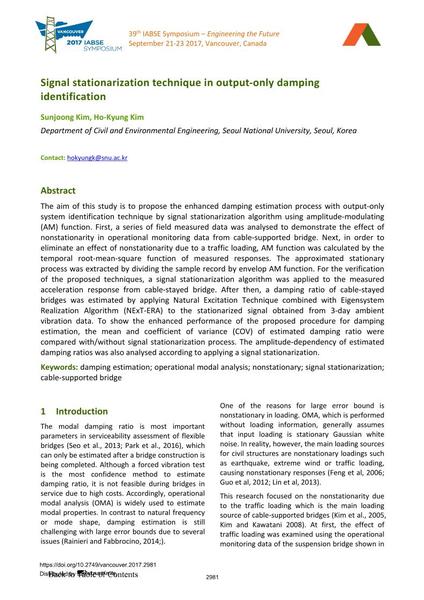Signal stationarization technique in output-only damping identification

|
|
|||||||||||
Détails bibliographiques
| Auteur(s): |
Sunjoong Kim
(Department of Civil and Environmental Engineering, Seoul National University, Seoul, Korea)
Ho-Kyung Kim |
||||
|---|---|---|---|---|---|
| Médium: | papier de conférence | ||||
| Langue(s): | anglais | ||||
| Conférence: | IABSE Symposium: Engineering the Future, Vancouver, Canada, 21-23 September 2017 | ||||
| Publié dans: | IABSE Symposium Vancouver 2017 | ||||
|
|||||
| Page(s): | 2981-2987 | ||||
| Nombre total de pages (du PDF): | 7 | ||||
| Année: | 2017 | ||||
| DOI: | 10.2749/vancouver.2017.2981 | ||||
| Abstrait: |
The aim of this study is to propose the enhanced damping estimation process with output-only system identification technique by signal stationarization algorithm using amplitude-modulating (AM) function. First, a series of field measured data was analysed to demonstrate the effect of nonstationarity in operational monitoring data from cable-supported bridge. Next, in order to eliminate an effect of nonstationarity due to a traffic loading, AM function was calculated by the temporal root-mean-square function of measured responses. The approximated stationary process was extracted by dividing the sample record by envelop AM function. For the verification of the proposed techniques, a signal stationarization algorithm was applied to the measured acceleration response from cable-stayed bridge. After then, a damping ratio of cable-stayed bridges was estimated by applying Natural Excitation Technique combined with Eigensystem Realization Algorithm (NExT-ERA) to the stationarized signal obtained from 3-day ambient vibration data. To show the enhanced performance of the proposed procedure for damping estimation, the mean and coefficient of variance (COV) of estimated damping ratio were compared with/without signal stationarization process. The amplitude-dependency of estimated damping ratios was also analysed according to applying a signal stationarization. |
||||
